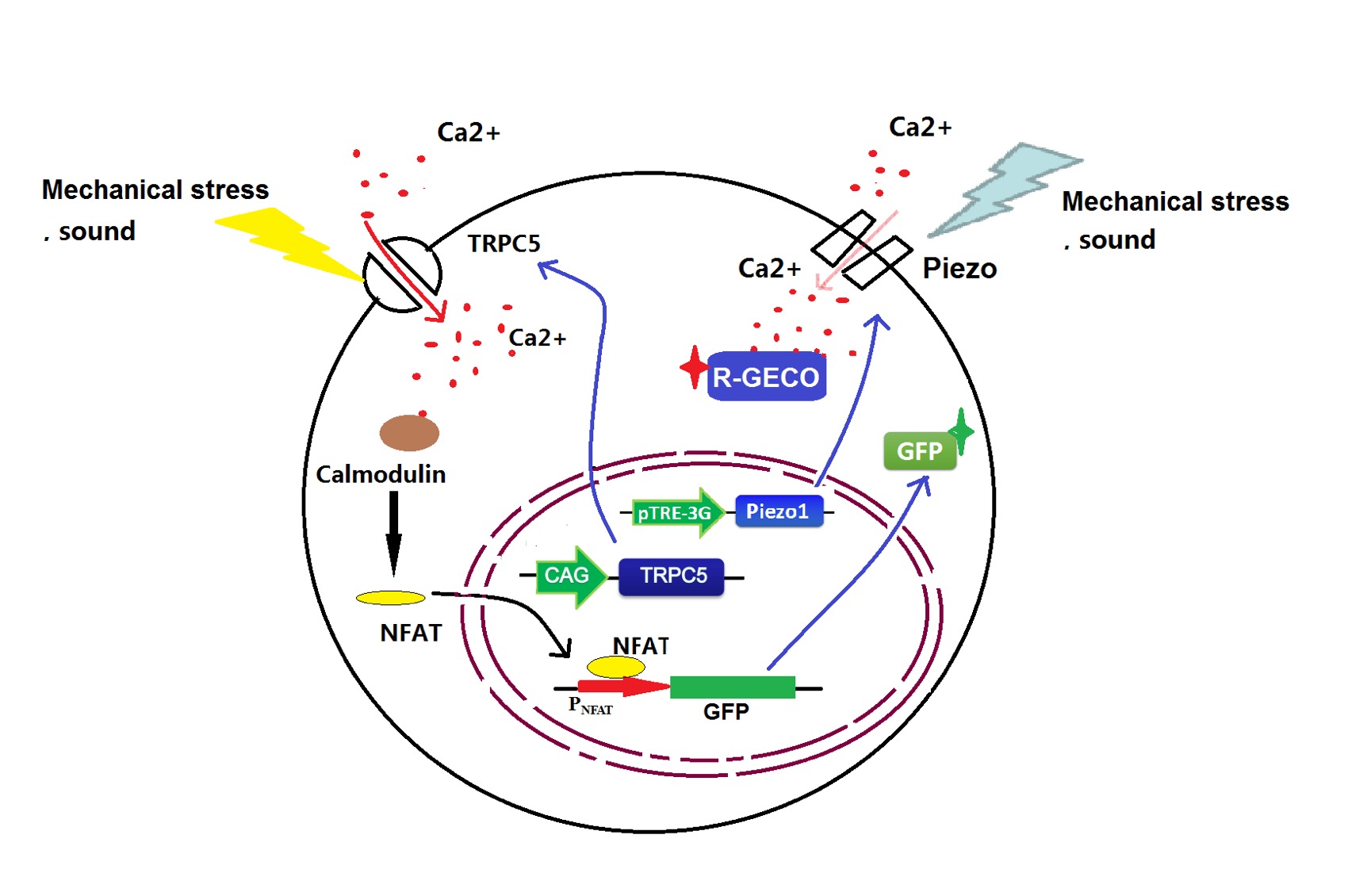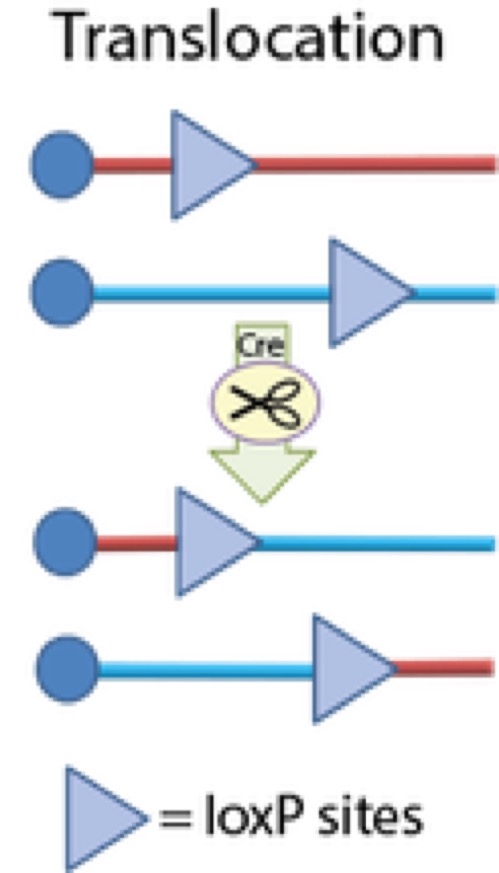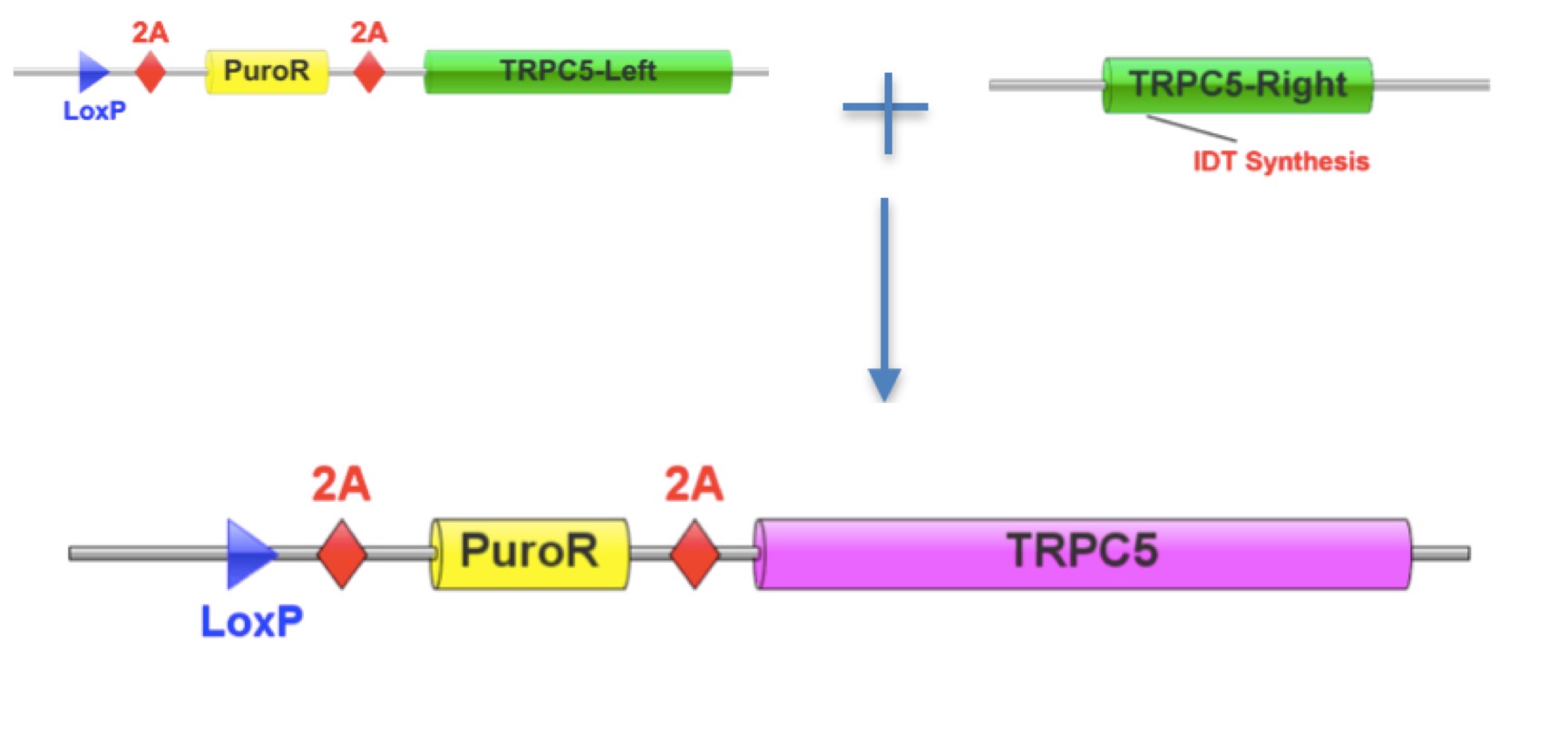
Plasmid Construction
Design
R-GECO
R-GECO is derived from GCaMP, a genetically encoded calcium indicator. After binding with calcium ion, it can emit red fluorescence at around 600nm. [1]
We use R-GECO to quantify the intracellular calcium level in CHO-K1 cell by using live cell imaging. Due to the instant conformational alteration of R-GECO, it can only be used in short-term test and observation. R-GECO can be inserted into CHO-K1 genomes by PiggyBac transposon system (Fig. 1) [2].
pBX087-NFAT-GFP
PNFAT is a promoter that can be activated by NFAT (nuclear factor of activated T cells).
After Ca2+ entering cell, it binds with calmodulin. The serine/threonine phosphatase calcineurin will then be activated, which dephosphorylates the serine-rich region and Serine-proline repeats in the amino terminus of NFAT. This activates a conformational change that exposes a nuclear localization signal, results in nuclear import, and enables binding of NFAT to specific promoters (PNFAT) and cooperation with resident transcription factors to induce transgene expression (Fig. 2) [2].
In the lab, we introduced GFP as an indicator of PNFAT downstream expression. After Ca2+ entering cell, the cascades could be activated, which could finally generate green fluorescence and demonstrate the result. Since the green fluorescent protein could express continuously once the cascade was activated, it was used for long-term test and observation.
Piezo1
Original Piezo1 plasmid was provided by Professor Maojun Yang from Tsinghua University. We used restriction enzyme digestion to insert it into a new backbone. It is a mammalian mechanosensitive channel. Piezo1 activity triggered by traction forces elicited influx of Ca2+ [3]. Piezo1 has broaden roles in multiple physiological processes, including sensing shear stress of blood flow for proper blood vessel development [4]. Piezo1 has broaden roles in multiple physiological processes, including sensing shear stress of blood flow for proper blood vessel development [5].
We employed various mechanical forces to stimulate the CHO-K1 cells transfected with Piezo1 plasmid and treated with doxycycline to promote TetON expression.
pBX097-NeoLoxp
pBX097-NeoLoxp was constructed by connecting the backbone (pBX097) which has PiggyBac sequence with the NeoLoxp fragment.
NeoLoxp is the combination of neomycin antibotic gene with Loxp sequence.
Neomycin gene could be used in later cell screening to get successfully transfected cell.
Loxp is a key component in Cre-loxp system (Fig. 3) [6][7]
In the lab, we firstly used PiggyBac system to integrate this plasmid containing Loxp into chromosome. After that, quantitative PCR was used to select cells with single copy of Loxp. This Loxp was then used to introduce TRPC5 into cell’s chromosome through Cre-Loxp recombination system (Fig. 4). Thus, we could compare the sensitivity of TRPC5 towards mechanical force quantitatively.
TRPC5
One part of TRPC5 was synthesized by IDT, another part was synthesized by Wuxi Qinglan Biotech Cooperation. We used polymerase chain reaction and restriction enzyme digestion to construct a complete and useful TRPC5 plasmid.
Similar to the experiment of Piezo1 plasmid, we used mechanical force including shear force, ultrasound vibration to stimulate the cells transfected with wild-type TRPC5 channel. Since it’s not so sensitive compared with Piezo1, we’ve done random mutagenesis in the ankyrin repeats of TRPC5, trying to screen the mutated plasmids which are quite sensitive to mechanical force.
References
- ↑ Zhao, Y., et al., An expanded palette of genetically encoded Ca(2)(+) indicators. Science, 2011. 333(6051): p. 1888-91.
- ↑ 2.0 2.1 Lu, X. and W. Huang, PiggyBac mediated multiplex gene transfer in mouse embryonic stem cell. PLoS One, 2014. 9(12): p. e115072.
- ↑ Pathak, M.M., et al., Stretch-activated ion channel Piezo1 directs lineage choice in human neural stem cells. Proc Natl Acad Sci U S A, 2014. 111(45): p. 16148-53.
- ↑ Li, J., et al., Piezo1 integration of vascular architecture with physiological force. Nature, 2014. 515(7526): p. 279-82.
- ↑ Ranade, S.S., et al., Piezo1, a mechanically activated ion channel, is required for vascular development in mice. Proc Natl Acad Sci U S A, 2014. 111(28): p. 10347-52.
- ↑ Sauer, B., Functional expression of the cre-lox site-specific recombination system in the yeast Saccharomyces cerevisiae. Mol Cell Biol, 1987. 7(6): p. 2087-96.
- ↑ Sauer, B. and N. Henderson, Site-specific DNA recombination in mammalian cells by the Cre recombinase of bacteriophage P1. Proc Natl Acad Sci U S A, 1988. 85(14): p. 5166-70.




